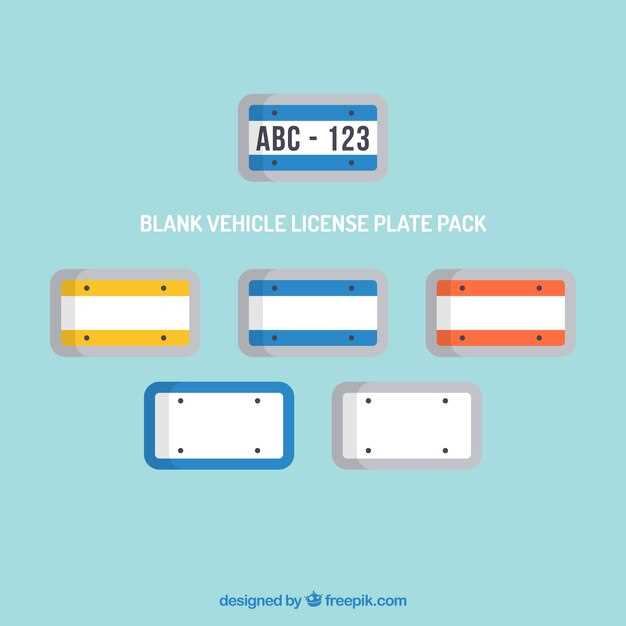
In the realm of automotive customization, the aesthetics of a vehicle often take center stage. However, enthusiasts must navigate the intricate landscape of legal regulations pertaining to license plate display. The rules governing how, where, and when plates should be displayed can vary significantly by jurisdiction, making it essential for vehicle owners to be aware of these requirements.
Adhering to legal guidelines is crucial not only for ensuring compliance but also for avoiding potential fines or penalties. Besides standard registration plates, many owners opt for customized tags that reflect personal style or sentiment. It’s important to balance creativity with legality, ensuring that any modifications or displays do not violate state regulations.
This guide will delve into the fundamental aspects of displaying plates on custom vehicles. From understanding relevant laws to tips on ensuring compliance, we aim to equip vehicle owners with the knowledge needed to enjoy their customized rides without the worry of legal repercussions. By following these guidelines, you can ensure that your vehicle stands out while staying within the bounds of the law.
Understanding Local Plate Display Regulations for Custom Builds
When customizing a vehicle, it is crucial to be aware of local regulations regarding license plate display. Each jurisdiction has specific laws governing where and how license plates must be affixed to vehicles. These requirements can vary significantly between states and municipalities, influencing the design and setup of custom builds.
Typically, most regions mandate that a standard license plate must be displayed prominently on the rear of the vehicle, with some areas also requiring a front plate. The plates should be securely fastened and visible, meaning they should not be obstructed by aftermarket components or modifications such as spoilers or custom bumpers.
Additionally, there are regulations concerning the size, color, and illumination of plates. Some jurisdictions may allow for certain decorative frames, but these must not obscure any part of the plate itself, including registration numbers or state seals. Furthermore, many areas prohibit the use of temporary or alternative plate designs unless specific permits are obtained.
Before completing a custom build, it is advisable to consult the local Department of Motor Vehicles (DMV) or equivalent authority to obtain detailed guidelines on plate display. Failing to adhere could result in fines or registration issues, ultimately affecting the legality of the vehicle on the road.
When designing a custom vehicle, consider integrating plate display areas that comply with regulations while complementing the overall aesthetic. Creative solutions can often satisfy legal requirements without sacrificing the design intent of the vehicle.
Navigating Restrictions on Plate Modifications and Designs

When customizing vehicles, one of the key legal considerations involves understanding the restrictions on modifications and designs of license plates. Each state has its own regulations that dictate what alterations can be made to license plates. These rules aim to maintain the legibility and integrity of plates for identification purposes.
Legibility and Visibility: Most jurisdictions require that license plates remain fully legible. This means that any modifications, such as alterations to the font or the addition of decorative elements, must not obstruct essential information, including registration numbers and state identifiers. Failure to comply can result in fines or penalties.
Reflective Materials: Many states mandate that license plates be made from reflective materials to enhance visibility at night. Modifying the surface of the plate, such as applying non-reflective coatings or stickers, is generally prohibited. It’s crucial to ensure that any design retains the necessary reflectivity to meet legal standards.
Plate Frames and Covers: While decorative frames and covers can enhance appearance, they must not cover any part of the plate. Laws often specify that frames should not obscure numbers, letters, or state seals. Using UV-resistant materials is recommended to prevent degradation of both the frame and the underlying plate.
Personalized Plates and Exceptions: Personalized plates offer opportunities for creative expression, but they still must conform to state rules regarding the allowable characters and combinations. Each state has a pre-approval process for personalized plates to ensure that designs do not include offensive language or misleading information. Check with your local Department of Motor Vehicles (DMV) for specific guidelines on what is permitted.
Penalties for Non-Compliance: Infringing upon plate modification laws can result in various consequences, ranging from warnings to fines. Repeated violations may lead to more severe penalties, including vehicle impoundment. Therefore, it is essential to stay informed about local regulations and ensure that any modifications are compliant.
In summary, navigating the complexities of license plate modifications requires careful attention to state regulations. By understanding what is allowed and what is not, vehicle owners can customize their plates while remaining within the bounds of the law.
Compliance with Special Permits and Inspections for Custom Vehicles

When it comes to custom vehicles, adhering to regulations concerning special permits and inspections is crucial. Each state has its own set of requirements that must be met before a custom vehicle can be legally driven on public roads.
Special Permits: Custom vehicles often require special permits due to modifications that may not conform to standard vehicle regulations. These permits ensure that the vehicle meets safety and emissions standards. Owners should research the specific permits needed in their state, which may include titles for reconstructed vehicles, exemption applications, or modifications to existing registrations.
Inspections: Custom vehicles typically undergo rigorous inspections to assess their compliance with state laws. These inspections often evaluate safety features, lighting, exhaust systems, and other critical components. It’s essential for vehicle owners to schedule inspections with certified officials who have the authority to approve alterations. Failure to comply with inspection requirements can result in fines, or the vehicle being deemed unroadworthy.
Additionally, maintaining proper documentation of all modifications, permits, and inspections is essential. This documentation serves as proof of compliance during law enforcement stops or when transferring ownership. Vehicle owners should keep receipts, inspection reports, and any correspondence with state agencies in an organized manner.
In conclusion, navigating the complexities of permits and inspections can be challenging, but it is essential for legally operating a custom vehicle. Engaging with local motor vehicle departments and understanding the specific legal landscape will facilitate a smoother process for compliance and ensure road legality.
